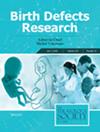Comorbidities and Healthcare Utilization Among Young Adults With Congenital Heart Defects by Down Syndrome Status—Congenital Heart Survey to Recognize Outcomes, Needs, and wellbeinG, 2016–2019
Abstract
Background
Almost half of individuals born with Down syndrome (DS) have congenital heart defects (CHDs). Yet, little is known about the health and healthcare needs of adults with CHDs and DS. Therefore, we examined comorbidities and healthcare utilization of this population.
Methods
Data were from the 2016–2019 Congenital Heart Survey to Recognize Outcomes, Needs, and well-beinG (CH STRONG), a survey of 19–38-year-olds with CHDs identified through birth defects registries in Arkansas, Arizona, and Atlanta. Outcome estimates were standardized to the CH STRONG eligible population. Multivariable Poisson regression generated adjusted prevalence ratios (aPRs) for associations between DS and each outcome, adjusting for covariates, including CHD severity.
Results
Among 1500 respondents, 9.1% had DS. Compared to those without DS, respondents with DS were more commonly male (55.5% vs. 45.0%), < 25 years old (51.8% vs. 42.7%), non-Hispanic White (72.3% vs. 69.3%), and publicly insured (77.4% vs. 22.8%; all p < 0.05). Of adults with CHDs and DS, 5.5% had cardiac comorbidities, 19.3% had emergency room (ER) visits, 6.2% had hospital admissions, and 1.2% had cost-related delays in care in the last year; 0.1 to 0.6 times lower than adults with CHDs without DS. Additionally, 26.7% had non-cardiac comorbidities (aPR = 1.25 [0.92–1.72]), most commonly sleep apnea (13.7% vs. 3.2%, aPR = 3.67 [2.02–6.67]). Receipt of cardiology care in the last 2 years was similarly low (52.7% vs. 44.7%).
Conclusions
Adults with CHDs and DS comprise a substantial percentage of adults with CHDs and have unique health and healthcare needs. Half of adults with CHDs and DS are not receiving recommended routine cardiac care.

 求助内容:
求助内容: 应助结果提醒方式:
应助结果提醒方式:


